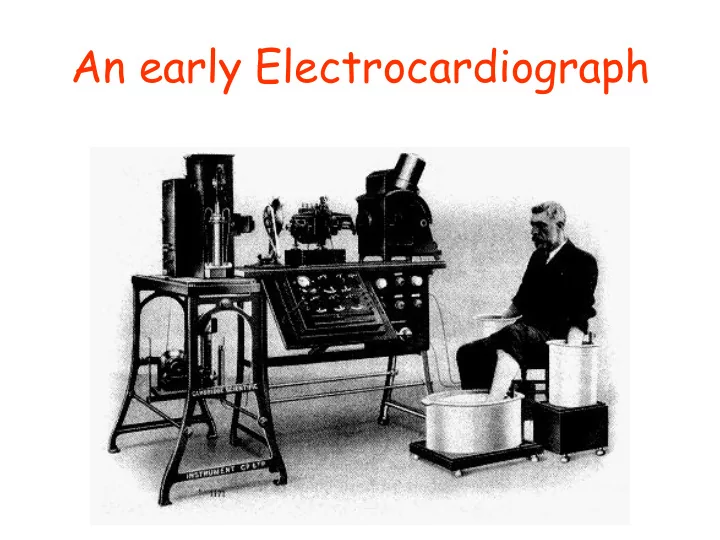

An early Electrocardiograph
Einthoven’s first published EKG, 1902
“I do not however imagine that the string galvanometer…is likely to find any very extensive use in the hospital” August D. Waller, 1909
The Electrocardiogram (ECG/EKG) Most Commonly Utilized Cardiovascular Lab Test 100 Million Performed per Year $5 Billion Cost per Year Reimbursements have dropped Key to Therapy for ACS/MI Diagnosis of Arrhythmias
Indications For An ECG Chest or Epigastric Altered Mental State Pain or Sensation (Coma, CVA) CHF Signs or Drug Overdose Chest Trauma Symptoms Syncope or Near Abnormal Pulse Hypotension Syncope Systemic Illness Unexplained Metabolic Disease Weakness Screening??
P’s and Q’s of Electrocardiography Ventricular Depolarization Ventricular Repolarization Atrial Depolarization http://medstat.med.utah.edu
RL/LL- side does not matter, place anywhere below umbilicus
The Electrocardiogram (ECG/EKG) Rhythms ST Segments
1 LAD 95%
1 LAD 95%
1 LAD 95%
1
1 LAD 0% Post PCI
Basic Principles of ECG Interpretation Place electrodes correctly (??) Be Careful to Get Correct Data Consider Clinical Context/Setting Chest pain? … consider ST segments Compare to Previous ECG Be Systematic Rate, Rhythm, ?Pacemaker Spikes QRS duration, Other intervals Axis Q waves Pattern read
QRS Prolongation (=>120msec, 3 40 msec boxes) Ventricular Origin PVCs Ventricular Tachycardia Ventricular Electronic Pacemaker SVT with Aberrant Conduction Bundle Branch Block Right (rabbit ears on the right) Left (rabbit ears on the left) WPW IntraVentricular Conduction Delay
Why is QRS Prolongation so important except for RBBB??? Q waves not diagnostic ST Depression not diagnostic Possibly Ventricular Origin Usually High Risk
1.000 0.750 Survival 0.500 1 (<110ms): N=38,943 (1.1%) 2 (110-120ms): N=4,787 (2.6%) 0.250 3 (120-130ms): N=481 (4.6%) 4 (>130ms): N=61 (6.6%) 0.000 0.0 2.0 4.0 6.0 8.0 10.0 12.0 14.0 Follow-up (yrs) F U pYears
Rabbit Ears Inverted Twave
RBBB
LBBB
Rabbit Ears Inverted Twave
IVCD
WPW
WPW
RA&LA Left Axis Extreme Axis +I/-AVF -AVF +I -I • RA LA Right Axis Normal +AVF Axis +I/+AVF -I/+AVF
RAD
LAD
S1S2S3
Criteria For Infarction Q Waves Equal or Greater than .04 seconds (one millimeter box horizontal width, 40 milliseconds) Q Wave Amplitude must be 25% or greater of following R Wave Pathophysiology: no muscle to generate R wave
Basic Principles of ECG Interpretation Place electrodes correctly (??) Be Careful to Get Correct Data Consider Clinical Context/Setting Chest pain? … consider ST segments Compare to Previous ECG Be Systematic Rate, Rhythm, ?Pacemaker Spikes QRS duration, Other intervals Axis Q waves Pattern read
inverted Qw, P/T up or down Right Left ventricular ventricular involvement: involvement: LVH, LBBB RVH, RBBB
Pattern Reading of the ECG Diagonal Line Rule box around aVR (everything inverted) line thru III, aVL, V1 every thing else upright Parallel Line Rule R waves increase then drop off in V6 S waves decrease from greatest in V1 Rabbit ears on right side (V1-2) for RBBB, on left side for LBBB
The 5 Commandments of ECG Interpretation • Be systematic • Put into the clinical context • Find an old ECG Watch out for bad • Watch out for bad data data – Strive for good data • Do NOT be afraid to get help
Watch for bad data!!
RA/LA reversed V1/V3 reversed
What happened?
Basic Principles of ECG Interpretation Be Systematic Rate: Fast-Normal-Slow Rhythm: Sinus, Blocks, Atrial, Ventricular Axis: Normal, Right, Left Intervals and Durations Intervals and Durations: Short ? Long ?
Intervals, segments, and durations
Intervals • PR Interval • QRS Duration • QT Interval PR interval QT Interval QRS duration Normal: .12-.20 sec Normal (corrected for Normal: .07- (3-5 small boxes) rate or QTc): .440-.470 .10 sec sec
Intervals: Conduction System Abnormalities Congenital Syndromes Electrolyte/Metabolic Abnormalities Intrinsic Cardiac Disease Medications CNS Disorders Systemic Illnesses
Electrolyte Abnormalities and the ECG Potassium Hyper: tall, peaked T waves (also ischemia), atrial arrest Hypo: prominent U waves, low T wave Calcium Hyper: short QT Hypo: long QT (also Quinidine, ischemia) Magnesium Hyper: short QT interval Hypo: long QT interval
Long QT intervals (>50% of the RR interval) • Congenital Ischemia Phenothiazines HypoMg/CA Tricyclics anti-arrhythmics CNS--Subarachnoid Myocarditis Hemorrhage Hypokalemia Torsades des Pointes
The QT interval Long QT (>50% of the RR interval) Congenital Short QT Hypomagnesium Hypercalcemia Hypocalcemia Hypermagnesium IA anti-arrhythmics Hyperkalemia Ischemia Digoxin Torsades de Pointes Thyrotoxicosis Phenothiazines Tricyclics Myocarditis Hypokalemia
Other Patterns • Atrial Abnormalities • R>S V1 http://medstat.med.utah.edu
SA Node
Atrial Abnormalities Right (P-pulmonale) Right atrium right heart border, first hump tall, peaked in inferior leads (>2.5mm) Left (P-mitrale) Left atrium posterior, second hump broad P wave (>120msec) with negative component in V1-2 (> 1mm x 1mm) Normal=2.5x2.5 boxes (100msec x .25Mv)
P pulmonale or RAA
P mitrale or LAA
Computerized LAA with/without P wave prolongation 1.0 0.8 Survival 0.6 a. LAA (-), P duration <120ms n=33,827 (1.3%) b. LAA (-), P duration >120ms n=4,476 (2.0%) 0.4 c. LAA (+), P duration <120ms n=1,273 (3.5%) d. LAA (+), P duration >120ms n=407 (4.7%) 0.2 Years Follow up 0.0 0.0 2.0 4.0 6.0 8.0 10.0 FUpYears
R>S V1 RVH RBBB Inferior Posterior MI WPW Normal Variant
Recommend
More recommend